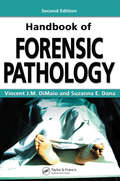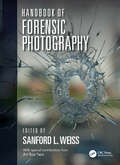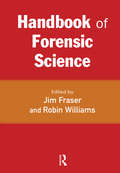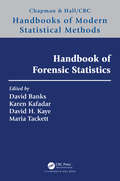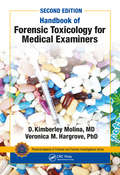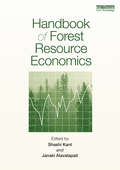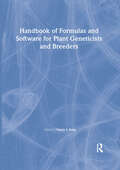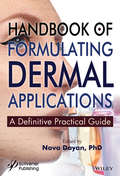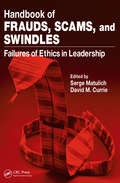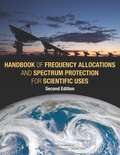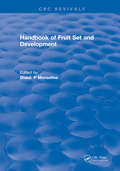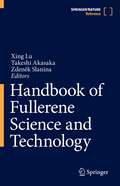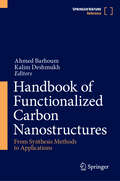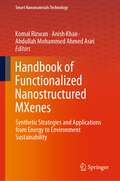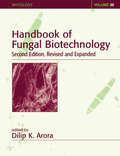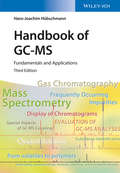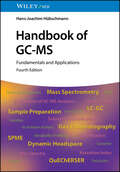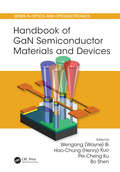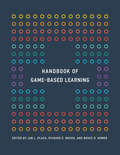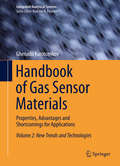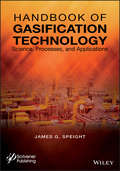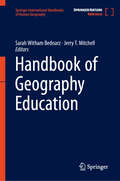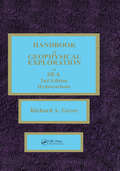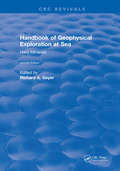- Table View
- List View
Handbook of Forensic Pathology
by Vincent J.M. DiMaio M.D. Suzanna E. Dana M.D.Handbook of Forensic Pathology, Second Edition is an up-to-date, concise manual illustrating all core aspects of modern forensic pathology. This edition retains the outline format of the original, which allows for quick access and rapid assimilation. Written in no-nonsense, easily understandable language, this precise and thorough yet compact resou
Handbook of Forensic Photography
by Sanford L WeissHandbook of Forensic Photography is the most-comprehensive, definitive reference for the use of photography in the capture and presentation of forensic evidence. The intent is to inform the reader about the most complete and up-to-date methods to capture and reproduce images that most accurately represent the evidence. With the rise in importance of forensic science, crime and accident scene documentation has likewise increased in importance—not the least of which has been forensic photography. The need to use accepted practice and protocols to guarantee the authenticity of images for evidence documentation is paramount for using it in court. And as with any discipline, there is an art to the science of forensic photography. Contributing authors from various backgrounds—each experts in their field—have provided numerous case examples, best practices, and recommendations for recognizing, recording, and preserving evidence using cameras and the latest digital image technology, including video and other imaging technologies. Chapters present such topics as videography, drone photography, underwater photography, crime scene photography, autopsy photographs, fire documentation, forensic odontology, and more. The book closes with coverage of courtroom displays, presenting imaging evidence and expert witness testimony in the courtroom. Handbook of Forensic Photography is a must-have reference for experienced crime scene photographers, death and crime scene investigators, police, and forensic professionals—including medical examiners, odontologists, engineers, and forensic anthropologists—who frequently need to capture investigative photographs in the course of investigations.
Handbook of Forensic Science
by Robin Williams Jim FraserForensic science has become increasingly important within contemporary criminal justice, from criminal investigation through to courtroom deliberations, and an increasing number of agencies and individuals are having to engage with its contribution to contemporary justice. This Handbook aims to provide an authoritative map of the landscape of forensic science within the criminal justice system of the UK. It sets out the essential features of the subject, covering the disciplinary, technological, organizational and legislative resources that are brought together to make up contemporary forensic science practice. It is the first full-length publication which reviews forensic science in a wider political, economic, social, technological and legal context, identifying emerging themes on the current status and potential future of forensic science as part of the criminal justice system. With contributions from many of the leading authorities in the field it will be essential reading for both students and practitioners.
Handbook of Forensic Statistics (ISSN)
by David Banks, Karen Kafadar, David H. Kaye and Maria TackettHandbook of Forensic Statistics is a collection of chapters by leading authorities in forensic statistics. Written for statisticians, scientists, and legal professionals having a broad range of statistical expertise, it summarizes and compares basic methods of statistical inference (frequentist, likelihoodist, and Bayesian) for trace and other evidence that links individuals to crimes, the modern history and key controversies in the field, and the psychological and legal aspects of such scientific evidence.Specific topics include uncertainty in measurements and conclusions; statistically valid statements of weight of evidence or source conclusions; admissibility and presentation of statistical findings; and the state of the art of methods (including problems and pitfalls) for collecting, analyzing, and interpreting data in such areas as forensic biology, chemistry, and pattern and impression evidence. The particular types of evidence that are discussed include DNA, latent fingerprints, firearms and toolmarks, glass, handwriting, shoeprints, and voice exemplars.
Handbook of Forensic Toxicology for Medical Examiners (Practical Aspects of Criminal and Forensic Investigations)
by D. K. Molina, M.D. Veronica HargroveForensic professionals, particularly medical examiners—often working through heavy caseloads—require quick and easy access to reliable sources of information to help interpret toxicology results. While several in-depth resources are available, they are often large, cumbersome, and contain more information than is often needed. The Handbook of Forensic Toxicology for Medical Examiners is a concise handbook referencing the most common toxic substances and their reported non-toxic, toxic, and lethal concentrations, making it an ideal text for quick reference in the lab or autopsy room. Features of the Second Edition: Explains the principles of postmortem toxicology and the factors which must be considered Provides tables of toxicologic data for over 200 commonly encountered substances, including drugs of abuse, poisons, prescription drugs, and over-the-counter medications Includes discussion and description of the novel psychoactive drugs—including synthetic opioids, cannabinoids, stimulants and hallucinogens Supplemental appendices provide additional information regarding specimen types and selection, testing methodologies, normal laboratory values, and conversion charts The busy forensic professional needs a concise handbook that provides critical information quickly and accurately. This heavily referenced text offers an easy-to-use format allowing for rapid access for both routine daily use and preparation for courtroom testimony.
Handbook of Forest Resource Economics (Routledge Environment and Sustainability Handbooks)
by Janaki R. R. Alavalapati Shashi KantIt is increasingly recognized that the economic value of forests is not merely the production of timber. Forests provide other key ecosystem services, such as being sinks for greenhouse gases, hotspots of biodiversity, tourism and recreation. They are also vitally important in preventing soil erosion and controlling water supplies, as well as providing non-timber forest products and supporting the livelihoods of many local people. This handbook provides a detailed, comprehensive and broad coverage of forest economics, including traditional forest economics of timber production, economics of environmental role of forests, and recent developments in forest economics. The chapters are grouped into six parts: fundamental topics in forest resource economics; economics of forest ecosystems; economics of forests, climate change, and bioenergy; economics of risk, uncertainty, and natural disturbances; economics of forest property rights and certification; and emerging issues and developments. Written by leading environmental, forest, and natural resource economists, the book represents a definitive reference volume for students of economics, environment, forestry and natural resource economics and management.
Handbook of Formulas and Software for Plant Geneticists and Breeders
by Manjit S. KangA simple solution to complicated statistical techniques and formulas! The Handbook of Formulas and Software for Plant Geneticists and Breeders is an up-to-date reference source that eliminates the need for hand calculations of complicated genetic formulas and equations. Contributions from members of the C1 Division of the Crop Science Society of America include computer program codes not found in Statistical Analysis System (SAS) and other commonly available statistical packages. The book provides an invaluable shortcut to sorting through piles of literature in search of programs that may have been published in abbreviated forms or never at all. The Handbook of Formulas and Software for Plant Geneticists and Breeders puts full-fledged program codes of specialized statistical and genetics-related software programs at your fingertips. It shows practicing geneticists, breeders, and students how to use specialized software through practical examples. The book is an excellent research and teaching tool in quantitative genetics and plant breeding, providing definitions of key terms and information on how to obtain desired software and key references. It also includes an extensive listing of programs available for linkage and mapping software that can be accessed through the Internet. The Handbook of Formulas and Software for Plant Geneticists and Breeders presents, among others, programs related to: genotype-by-environmental interaction (GEI) and stability analysis genetic diversity estimation best linear unbiased predictors (BLUPs) principal component and additive main effects and multiplicative interaction (AMMI) analyses quantitative trait loci -by-environment (QTL x E) analysis GGE biplot analysis diallel analyses path analysis trend analysis field plot technique The Handbook of Formulas and Software for Plant Geneticists and Breeders is essential for academics and researchers working in genetics, breeding, and genomics, and as a supplement for coursework in quantitative genetics and plant breeding.
Handbook of Formulating Dermal Applications: A Definitive Practical Guide
by Nava DayanThe conceptualization and formulation of skin care products intended for topical use is a multifaceted and evolving area of science. <p><p> Formulators must account for myriad skin types, emerging opportunities for product development as well as a very temperamental retail market. Originally published as “Apply Topically” in 2013 (now out of print), this reissued detailed and comprehensive handbook offers a practical approach to the formulation chemist’s day-to-day endeavors by: <p> • Addressing the innumerable challenges facing the chemist both in design and at the bench, such as formulating with/for specific properties; formulation, processing and production techniques; sensory and elegancy; stability and preservation; color cosmetics; sunscreens; <p> • Offering valuable guidance to troubleshooting issues regarding ingredient selection and interaction, regulatory concerns that must be addressed early in development, and the extrapolation of preservative systems, fragrances, stability and texture aids; <p> • Exploring the advantages and limitations of raw materials; <p> • Addressing scale-up and pilot production process and concerns; <p> • Testing and Measurements Methods. <p> The 22 chapters written by industry experts such as Roger L. McMullen, Paul Thau, Hemi Nae, Ada Polla, Howard Epstein, Joseph Albanese, Mark Chandler, Steve Herman, Gary Kelm, Patricia Aikens, and Sam Shefer, along with many others, give the reader and user the ultimate handbook on topical product development.
Handbook of Frauds, Scams, and Swindles: Failures of Ethics in Leadership
by David M. Currie Serge MatulichIt has been said that scammers and swindlers often display characteristics commonly attributed to good leadership. These include setting a vision, communicating it clearly, and motivating others to follow their lead. But when these skills are used by unconscionable people to satisfy greed, how can the average person recognize that foul play is afoo
Handbook of Frequency Allocations and Spectrum Protection for Scientific Uses: Second Edition
by Panel on Frequency Allocations Spectrum Protection for Scientific UsesThe electromagnetic spectrum is a vital part of our environment. Measures of radio frequency emissions from natural phenomena enable both practical applications, such as weather predictions and studies of the changing of Earth's climate here at home, and reveal the physical properties of cosmic sources. The spectrum is therefore a resource to be used wisely now and to be protected for future generations. "Handbook of Frequency Allocations and Spectrum Protection for Scientific Uses: Second Edition" sets forth the principles for the allocation and protection of spectral bands for services using the radio spectrum for scientific research. This report describes the radio frequency bands used by scientific services and includes relevant regulatory information and discussion of scientific use of frequency bands. This reference will guide spectrum managers and spectrum regulatory bodies on science issues and serve as a resource to scientists and other spectrum users.
Handbook of Fruit Set and Development
by Shaul. P MonseliseDifferent phases of fruit development and utilization have been treated in many textbooks, reviews, and a host of scientific and professional papers. This seems, however, to be the first attempt to bring together case histories of so many different fruits and to present a balanced account of the whole period from set to harvest. Postharvest physiology, which has been in the centre of the picture in many former books, is at the bored line of the subject matter of this book, and has not been fully covered, except in a few cases. For this reason, two separate chapters deal with physiological and pathological aspects of fruit life after harvest.
Handbook of Fullerene Science and Technology
by Takeshi Akasaka Xing Lu Zdeněk SlaninaNanocarbon chemistry and physics is a fast-developing, broad research area – the Nobel prizes in 1996 and 2010 awarded to two key discoveries in the field, and several other nanocarbon achievements of comparable importance. Owing to this rapid growth, the nanocarbon landscape fundamentally changes every few years, creating a need to survey the field on a regular basis to update the books that have become incomplete or even obsolete. As such, this book focuses on fullerenes and metallofullerenes and also on the related areas of nanotubes and graphenes. All the covered research topics provide important fundamental knowledge for the natural sciences, but also for applications in molecular electronics, superconductivity, catalysis, photovoltaics and medical diagnostics. The current nanocarbon research activities have particularly high application potential in the conversion of solar energy, future molecular memories, non-conventional materials for optoelectronics, and new treatments for civilization diseases. Offering a truly up-to-date critical survey of nanocarbon science, its concepts and highlights, it follows the concept of a handbook: it addresses key topics systematically, from historical background, methodological aspects, current important issues, and application potential, all supplied with extensive referencing. With individual chapters written by leading experts with extensive research experience, it is a comprehensive reference resource for graduate students and active researchers alike.
Handbook of Functional Neuroimaging of Cognition
by Roberto Cabeza Alan KingstoneThe theoretical and methodological developments in the use of functional neuroimaging techniques to study the neural basis of cognition, from early scientific efforts to link brain and behavior to the latest applications of fMRI and PET methods.
Handbook of Functionalized Carbon Nanostructures: From Synthesis Methods to Applications
by Ahmed Barhoum Kalim DeshmukhThis book highlights all newly reported carbon nanostructures including graphene and its derivatives, carbon nanotubes, metal organic frameworks, fullerenes, nanorods, nanospheres, nano onions, porous nanoparticles, nanohorns, nanofibers and nanoribbons, nanodiamonds, graphitic carbon nitrides, carbon aerogels and hydrogels, graphdiyne and graphenylene. It presents the historical development of carbon nanostructures technologies, different types and classifications, and different fabrication and functionalization techniques, including outer/inner surface functionalization and covalent and noncovalent functionalization. This Handbook discusses the unique properties of functionalized carbon nanostructures that can be obtained by modifying their structures, composition, and surface. It gives the reader an in-depth look at the current achievements of research and practice while pointing you ahead to new possibilities in functionalizing and using carbon nanomaterials. Finally, it covers the various applications of functionalized carbon nanostructures including adsorbents, additives, active materials in energy accumulating systems (batteries, hydrogen storage systems, and supercapacitors), filtering media, catalysts or supports for catalysts, sensors or substrates for sensors, additives for polymers, ceramic composites, metal and carbon alloys, glasses, digital textiles, and composite materials.
Handbook of Functionalized Nanostructured MXenes: Synthetic Strategies and Applications from Energy to Environment Sustainability (Smart Nanomaterials Technology)
by Anish Khan Komal Rizwan Abdullah Mohammed Ahmed AsiriThis book covers the various aspects of MXenes nanomaterials and its composites from the fabrication to the potential applications in energy devices, sensors, and environmental remediation. MXenes are two-dimensional (2D) transition metal carbides and nitrides which contains novel combination of properties including great conductivity and mechanical, thermal features of transition metal carbide and nitrides. In addition, MXenes nanomaterials possess high surface area, novel morphology, and layered structure and the functionalized of its surfaces gives it excellent hydrophilic characteristics and high absorption of electromagnetic radiations making them versatile materials for various applications. The beginning part of the book gives an in-depth literature covering the fundamental principles, fabrication, self-assembling strategies of nano-engineered MXenes, and their composites materials. The later chapters describe the chemical functionalization of MXenes nanomaterials for diversified applications such as electromagnetic shielding, energy storage devices (super capacitors, lithium ion batteries, CO2 capture, optical switching, transistors), photo catalysis, drug delivery, implants, tissue engineering, water purification, and sensing applications. It demonstrates that MXene-based advanced architectures promote continuous innovations and provide driving force in different fields particularly in environmental remediation and energy storage devices. This book is essential reading for all chemists, biologists, physicists, and environmental scientists working in the field of nanotechnology, energy, and environmental chemistry. It helps academics and professionals to polish their knowledge with the latest described data. It also helps professionals in developing innovative technologies by keeping in mind the applications of functionalized nanostructured MXenes.
Handbook of Fungal Biotechnology (Mycology)
by Dilip K. Arora Paul D.Bridge and Deepak BhatnagarThe Handbook of Fungal Biotechnology offers the newest developments from the frontiers of fungal biochemical and molecular processes and industrial and semi-industrial applications of fungi. This second edition highlights the need for the integration of a number of scientific disciplines and technologies in modern fungal biotechnology and reigns as
Handbook of GC-MS
by Hans-Joachim HübschmannThe only comprehensive reference on this popular and rapidly developing technique provides a detailed overview, ranging from fundamentals to applications, including a section on the evaluation of GC-MS analyses. As such, it covers all aspects, including the theory and principles, as well as a broad range of real-life examples taken from laboratories in environmental, food, pharmaceutical and clinical analysis. It also features a glossary of approximately 300 terms and a substance index that facilitates finding a specific application. For this new edition the work has been now extended to two volumes, reflecting the latest developments in the technique and related instrumentation, while also incorporating several new examples of applications in many fields. The first two editions were very well received, making this handbook a must-have in all analytical laboratories using GC-MS.
Handbook of GC-MS: Fundamentals and Applications
by Hans-Joachim HubschmannEssential handbook for all analytical scientists and laboratories using GC-MS, covering both the fundamental and practical aspects of this analytical technique From essentials to applications, Handbook of GC-MS:Fundamentals and Applications is a comprehensive reference and training compendium on the popular and evolving technique of GC-MS (gas chromatography/mass spectrometry), guiding readers through the most used sample preparation methods for GC-MS and method development, with many practical indications supporting the design of optimized analyses, and providing practical approaches to data processing, compound identification, and quantification. The text details both a solid background and principles of operation, as well as a broad range of current real-life examples taken from laboratories in environmental, food, pharmaceutical, and forensic analysis. It also features a glossary of more than 300 terms, and a comprehensive substance index that facilitates finding a specific application. This timely Fourth Edition covers the latest developments in automated sample preparation techniques and instrumentation, also with the focus on Green Analytical Chemistry. This comprehensive handbook presents GC-MS applications in various fields, with coverage of the well-known QuEChERS pesticide extraction, solid phase extraction and solid phase microextraction, static and dynamic headspace analysis, liquid/liquid extraction, outgassing, and thermal desorption, including pyrolysis. Single and triple quadrupole, Orbitrap, time-of-flight, magnetic sector, ion mobility and isotope ratio MS are discussed with their advantages and limitations. Sample topics covered in Handbook of GC-MS: Fundamentals and Applications include: Sample inlet systems for hot needle, liquid band injection with large volume and LC-GC application, carrier gas saving, choice of columns, septa and injection port linersOptimization of the GC method with carrier gas flow, effect of oven temperature ramp rates, fast GC, and multi-dimensional gas chromatographyIonization processes, electron and chemical ionization, resolution power in mass spectrometry, reading and interpreting mass spectraExtraction of mass spectra, manual spectrum subtraction, deconvolution of mass spectra, retention index, and library search of mass spectraTypical mass spectra of common analyte groups like pesticides, persistent organic pollutants, drugs; explosives; and of frequently occurring impuritiesQuantification using external and internal standards and standard addition methods. Determination of the limits of detection and quantitation.Applications covering food, water, flavor and fragrance, metabolomics, forensic and material analysis The Handbook of GC-MS: Fundamentals and Applications is an essential reference for the daily GC-MS practice and application of new methods. It serves as an excellent introduction for newcomers as well as an educational resource about this analytical technique. Analytical chemists, chromatographers, environmental chemists, food chemists, and pharmaceutical chemists will find it of high practical use.
Handbook of GaN Semiconductor Materials and Devices (Series in Optics and Optoelectronics)
by Bo Shen Wengang Wayne Bi Haochung Henry Kuo Peicheng KuThis book addresses material growth, device fabrication, device application, and commercialization of energy-efficient white light-emitting diodes (LEDs), laser diodes, and power electronics devices. It begins with an overview on basics of semiconductor materials, physics, growth and characterization techniques, followed by detailed discussion of advantages, drawbacks, design issues, processing, applications, and key challenges for state of the art GaN-based devices. It includes state of the art material synthesis techniques with an overview on growth technologies for emerging bulk or free standing GaN and AlN substrates and their applications in electronics, detection, sensing, optoelectronics and photonics. Wengang (Wayne) Bi is Distinguished Chair Professor and Associate Dean in the College of Information and Electrical Engineering at Hebei University of Technology in Tianjin, China. Hao-chung (Henry) Kuo is Distinguished Professor and Associate Director of the Photonics Center at National Chiao-Tung University, Hsin-Tsu, Taiwan, China. Pei-Cheng Ku is an associate professor in the Department of Electrical Engineering & Computer Science at the University of Michigan, Ann Arbor, USA. Bo Shen is the Cheung Kong Professor at Peking University in China.
Handbook of Game-Based Learning (The\mit Press Ser.)
by Jan L. Plass Richard E. Mayer Bruce D. HomerA comprehensive introduction to the latest research and theory on learning and instruction with computer games.This book offers a comprehensive introduction to the latest research on learning and instruction with computer games. Unlike other books on the topic, which emphasize game development or best practices, Handbook of Game-Based Learning is based on empirical findings and grounded in psychological and learning sciences theory. The contributors, all leading researchers in the field, offer a range of perspectives, including cognitive, motivational, affective, and sociocultural. They explore research on whether (and how) computer games can help students learn educational content and academic skills; which game features (including feedback, incentives, adaptivity, narrative theme, and game mechanics) can improve the instructional effectiveness of these games; and applications, including games for learning in STEM disciplines, for training cognitive skills, for workforce learning, and for assessment. The Handbook offers an indispensable reference both for readers with practical interests in designing or selecting effective game-based learning environments and for scholars who conduct or evaluate research in the field. It can also be used in courses related to play, cognition, motivation, affect, instruction, and technology.ContributorsRoger Azevedo, Ryan S. Baker, Daphne Bavelier, Amanda E. Bradbury, Ruth C. Clark, Michele D. Dickey, Hamadi Henderson, Bruce D. Homer, Fengfeng Ke, Younsu Kim, Charles E. Kinzer, Eric Klopfer, James C. Lester, Kristina Loderer, Richard E. Mayer, Bradford W. Mott, Nicholas V. Mudrick, Brian Nelson, Frank Nguyen, V. Elizabeth Owen, Shashank Pawar, Reinhard Pekrun, Jan L. Plass, Charles Raffale, Jonathon Reinhardt, C. Scott Rigby, Jonathan P. Rowe, Richard M. Ryan, Ruth N. Schwartz, Quinnipiac Valerie J. Shute, Randall D. Spain, Constance Steinkuehler, Frankie Tam, Michelle Taub, Meredith Thompson, Steven L. Thorne, A. M. Tsaasan
Handbook of Gas Sensor Materials
by Ghenadii KorotcenkovThe two volumes of Handbook of Gas Sensor Materials provide a detailed and comprehensive account of materials for gas sensors, including the properties and relative advantages of various materials. Since these sensors can be applied for the automation of myriad industrial processes, as well as for everyday monitoring of such activities as public safety, engine performance, medical therapeutics, and in many other situations, this handbook is of great value. Gas sensor designers will find a treasure trove of material in these two books.
Handbook of Gasification Technology: Science, Processes, and Applications
by James G. SpeightGasification is one of the most important advancements that has ever occurred in energy production. Using this technology, for example, coal can be gasified into a product that has roughly half the carbon footprint of coal. On a large scale, gasification could be considered a revolutionary development, not only prolonging the life of carbon-based fuels, but making them “greener” and cleaner. As long as much of the world still depends on fossil fuels, gasification will be an environmentally friendlier choice for energy production. But gasification is not just used for fossil fuels. Waste products that would normally be dumped into landfills or otherwise disposed of can be converted into energy through the process of gasification. The same is true of biofeedstocks and other types of feedstocks, thus making another argument for the widespread use of gasification. The Handbook of Gasification Technology covers all aspects of the gasification, in a “one-stop shop,” from the basic science of gasification and why it is needed to the energy sources, processes, chemicals, materials, and machinery used in the technology. Whether a veteran engineer or scientist using it as a reference or a professor using it as a textbook, this outstanding new volume is a must-have for any library.
Handbook of Geography Education (Springer International Handbooks of Human Geography)
by Sarah Witham Bednarz Jerry T. MitchellThis handbook presents a broad and comprehensive overview of research and practices in geography education at primary and secondary levels (from birth to about age 18). It summarizes the current state of knowledge in this sub-discipline of geography. Including authors representative of many geography education traditions, the book pays equal attention to learning and teaching and to respect student voices, and includes rich in case studies, evidence-based research, and specific examples. It also emphasizes ways that geography education can contribute to global concerns about social justice, diversity, equity, and inclusion as well as ways it can help to prepare the next generation of informed, critical, and reflective members of societies. The book is divided into five sections: · Purposes of geography education—Why is it taught? · Perspectives on geography education—Whatis taught? · Practices of geography education—How is it organized and taught? · Preparation of geography educators—How are geography educators prepared? · Possibilities for geography education—What is/are the future(s) of geography education By providing broad perspectives and lively and accessible writing, this handbook is a useful tool for novice geography educators, teacher educators, educational policy makers, support staff such as librarians and media resource specialists, curriculum developers, and assessment experts in many world regions.
Handbook of Geophysical Exploration at Sea
by Richard A. Geyer Margaret AshwellThis two-volume handbook presents advanced research and operational information about hard minerals and hydrocarbons. It provides information in an integrated, interdisciplinary manner, stressing case histories. It includes review chapters, illustrations, graphs, tables, and color satellite images that present the results of gravity, geodetic, and seismic surveys and of 3-D sea floor sub-bottom visualizations. The data was obtained using satellites, aircraft, and ships from the Atlantic and Pacific Oceans, the Gulf of Mexico, and the Caribbean Sea. Major topics addressed in these volumes include geophysical methods used to explore for hydrocarbons, advanced radiometric and electrical methods for hard mineral searches, the role of geotechnology and seismic acoustics in overcoming geological hazards in selecting drilling sites and pipeline routes, and remote sensing techniques used to determine the physical properties of sediments.
Handbook of Geophysical Exploration at Sea: 2nd Editions - Hard Minerals
by Richard A. GeyerThis handbook presents advanced research and operational information about hard minerals and hydrocarbons. It provides information in an integrated, interdisciplinary manner, stressing case histories. It includes review chapters, illustrations, graphs, tables, and color satellite images that present the results of gravity, geodetic, and seismic surveys and of 3-D sea floor sub-bottom visualizations. The data was obtained using satellites, aircraft, and ships from the Atlantic and Pacific Oceans, the Gulf of Mexico, and the Caribbean Sea.Major topics addressed in these volumes include geophysical methods used to explore for hydrocarbons, advanced radiometric and electrical methods for hard mineral searches, the role of geotechnology and seismic acoustics in overcoming geological hazards in selecting drilling sites and pipeline routes, and remote sensing techniques used to determine the physical properties of hydrocarbons.
